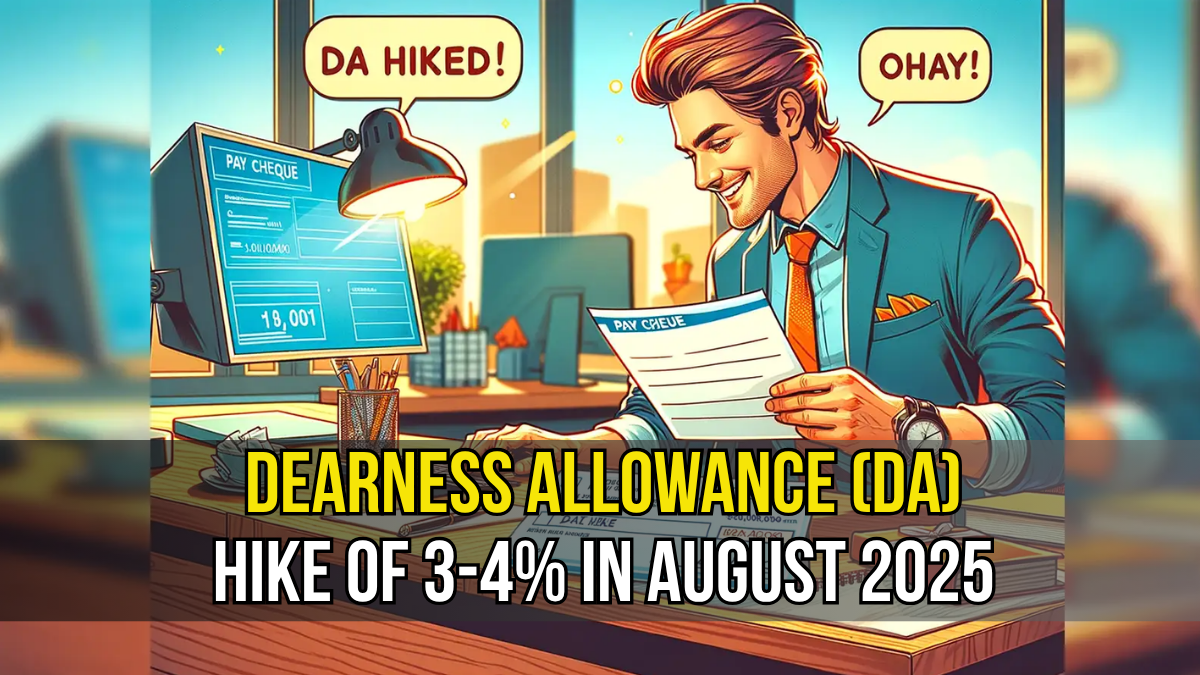Central government employees and pensioners across India are eagerly awaiting potential good news. Reports suggest the government may announce a Dearness Allowance (DA) hike of 3-4% in August 2025, with the increased amount potentially reaching beneficiaries before Raksha Bandhan. This development could bring significant financial relief to millions of government workers nationwide.
Currently, central government employees receive 55% DA, following a 2% increase implemented in March 2025. However, rising inflation indicators suggest another adjustment may be on the horizon. With inflation data showing upward trends, the government appears poised to provide additional compensation to help employees cope with increasing living costs.

The timing of this potential announcement holds special significance. If approved, the DA hike would take effect from August 2025, meaning employees could receive their enhanced allowances just before the festive season of Raksha Bandhan. This timing would provide much-needed financial support during a period when many families increase their spending on celebrations and gifts.
Understanding the DA Review Process
The government follows a systematic approach to reviewing Dearness Allowance twice annually. The first review typically occurs in February-March, with implementation from January. The second review happens in September-October, affecting payments from August onwards.
This structured timeline ensures employees receive regular adjustments to counteract inflation’s impact on their purchasing power. The dual review system allows the government to respond more quickly to changing economic conditions rather than making annual adjustments that might lag behind inflation trends.
DA serves central government employees, while pensioners receive Dearness Relief (DR) under similar calculation methods. Both allowances aim to maintain the real value of government compensation packages as prices rise across the economy.
How DA Calculations Work
The calculation of Dearness Allowance relies on the All India Consumer Price Index for Industrial Workers (AICPI-IW). This comprehensive index tracks price changes across 317 markets in 88 industrial centers throughout India, providing a representative picture of inflation’s impact on working families.
The Labor Bureau, operating under the Ministry of Labor and Employment, releases monthly AICPI-IW data. This information forms the foundation for DA calculations using a specific formula established under the 7th Pay Commission:
Dearness Allowance (%) = [(12-month average CPI-IW – 261.42) ÷ 261.42] × 100
In this formula, 261.42 represents the base index value determined by the 7th Pay Commission. The calculation uses the average of 12 months of CPI-IW data to smooth out monthly fluctuations and provide a more stable basis for adjustments.
Recent data shows the CPI-IW index rose from 143 in March 2025 to 144 by May 2025. If this trend continues or remains stable through June, it supports projections for a 3-4% DA increase.
Current Inflation Trends and Their Impact
While industrial worker inflation shows upward movement, broader economic indicators present a mixed picture. Rural inflation data reveals some moderation, with retail inflation for agricultural workers declining to 2.84% in May 2025, down from 3.5% in April. Similarly, inflation for rural workers dropped to 2.97% during the same period.
The Consumer Price Index for Agricultural Laborers (CPI-AL) and Rural Laborers (CPI-RL) both declined marginally to 1305 and 1319 points respectively. These figures indicate that rural areas experienced some relief from inflationary pressures during May 2025.
However, these rural inflation measures don’t directly influence DA calculations. The government specifically uses CPI-IW data, which focuses on industrial workers rather than agricultural or rural workers. This distinction matters because industrial workers often face different price pressures than their rural counterparts.
The stability or modest increase in CPI-IW data through June 2025 will ultimately determine the exact percentage of any DA hike. Current projections suggest the increase could raise total DA from 55% to either 58% or 59%, depending on the final calculations.
Financial Impact on Government Employees
A 3-4% DA increase would represent substantial additional income for central government employees. For someone earning ₹50,000 monthly, a 3% DA hike would add ₹1,500 to their monthly compensation. Over a full year, this translates to ₹18,000 in additional income.
The cumulative effect becomes even more significant when considering that DA applies to the basic pay amount. Higher-paid employees would see proportionally larger increases in absolute terms, though the percentage remains consistent across pay grades.
For pensioners receiving Dearness Relief, the impact follows similar patterns. A retired government employee receiving ₹30,000 monthly pension would gain ₹900 per month from a 3% increase, totaling ₹10,800 annually.
These amounts may seem modest individually, but their collective impact on millions of government employees and pensioners represents billions of rupees in additional government expenditure and increased consumer spending power.

Economic Implications and Government Considerations
The government must balance multiple factors when deciding on DA hikes. While employees deserve protection from inflation, increased DA payments represent significant fiscal commitments. With millions of central government employees and pensioners eligible for these benefits, even small percentage increases translate to substantial budget impacts.
Higher DA payments can stimulate economic activity as recipients spend their additional income on goods and services. This increased consumption can particularly benefit local economies where government employees live and work.
However, the government must also consider broader economic conditions, including fiscal deficit targets and overall inflation management. Excessive increases in government compensation could potentially contribute to inflationary pressures if not carefully managed.
The timing of DA announcements often reflects these broader considerations. Announcing increases before festivals like Raksha Bandhan can provide economic stimulus when consumer spending typically rises, supporting local businesses and economic activity.
Historical Context and Future Expectations
DA adjustments have been a consistent feature of central government employment for decades. The current 7th Pay Commission framework, implemented in 2016, established the methodology still used today for these calculations.
Previous DA hikes have generally ranged from 2-5% per adjustment, depending on inflation trends during the relevant periods. The proposed 3-4% increase falls within this typical range, suggesting the government continues following established precedents.
Looking ahead, employees can expect continued biannual reviews of DA rates. The government’s commitment to maintaining purchasing power through these adjustments remains a key benefit of central government employment.
Climate change, global supply chain disruptions, and energy price volatility may create new inflationary pressures in coming years. These factors could influence future DA calculations and adjustment frequencies.
Take Action on Your Financial Planning
If you’re a central government employee or pensioner, this potential DA hike offers an opportunity to reassess your financial planning. Consider how additional income might support your savings goals, debt reduction plans, or investment strategies.
For those approaching retirement, understanding DA trends can help in making informed decisions about pension planning and retirement timing. The consistent protection against inflation that DA provides represents a valuable benefit of government service.
Stay informed about official announcements from the government regarding DA hikes. While current indicators suggest an increase is likely, only official confirmation will provide certainty about timing and exact percentages.
Use this potential windfall wisely by directing additional income toward emergency funds, debt repayment, or long-term investments that can provide security for your financial future.
FAQs About Dearness Allowance Increase
Q1. What is a DA hike?
A. A DA (Dearness Allowance) hike refers to an increase in the allowance provided to government employees and pensioners to help offset the impact of inflation on their cost of living. It is a percentage of the basic salary and is revised periodically.
Q2. When is the next DA hike expected?
A. The next DA hike is expected before Raksha Bandhan in 2025. It is anticipated to increase by 3-4%, raising the current DA from 55% to 58-59%.
Q3. How is the percentage of DA hike determined?
A. The percentage of the DA hike is determined based on inflation data, particularly the Consumer Price Index for Industrial Workers (CPI-IW), which tracks changes in retail prices.
Q4. Who is eligible to receive the DA hike?
A. The DA hike applies to central government employees and pensioners. It is aimed at mitigating the rising cost of living due to inflation.
Q5. How can employees make the best use of the DA hike?
A. Employees can use the additional income from the DA hike to bolster emergency funds, pay off debts, or invest in long-term financial goals, ensuring enhanced financial security for the future.
Click HERE For More.
